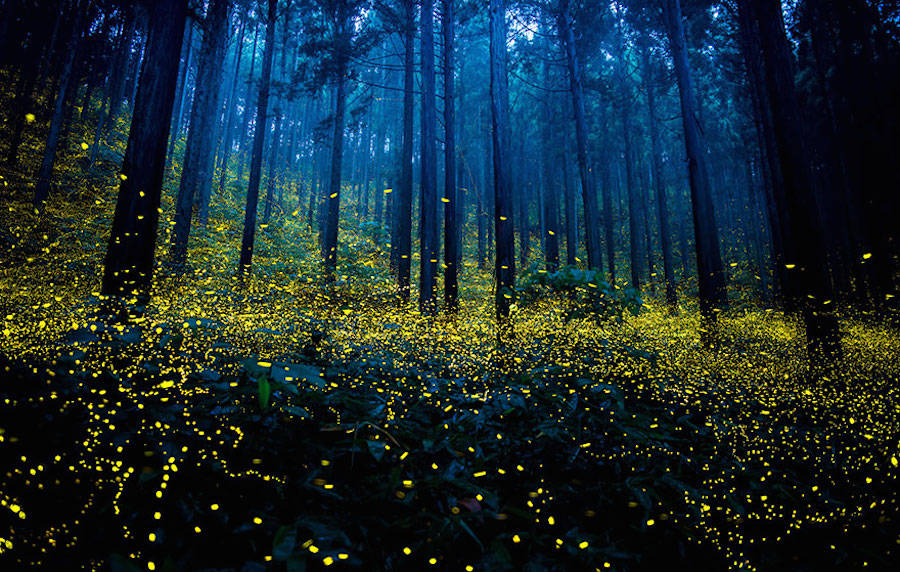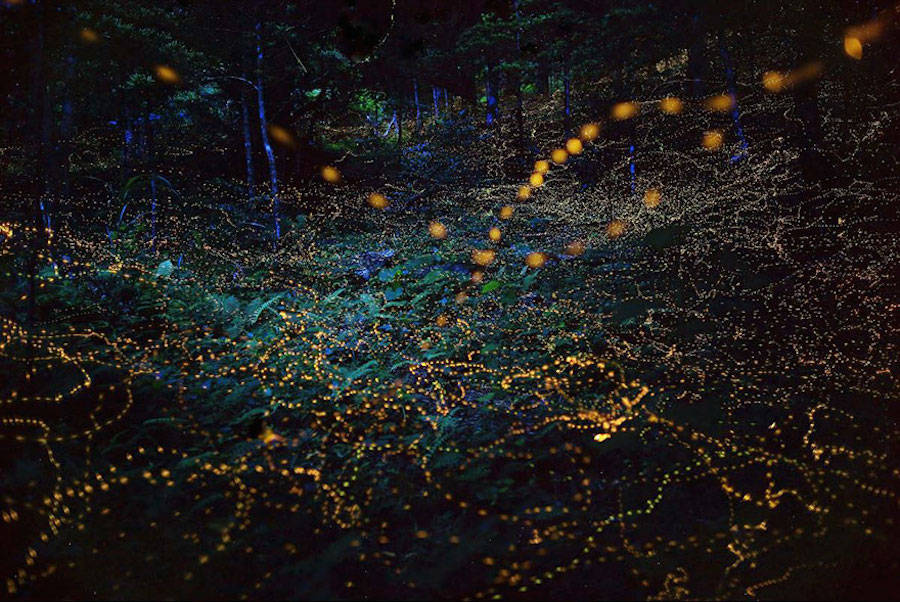The birds, the bees, chimpanzees, humans – we all do it, but few people realise that sexual reproduction actually first evolved in creatures vastly different to ourselves.
So what were they and how did it all start? What is the real story of the birds and the bees?
The dawn of sexual reproduction has always been a puzzle for scientists. Today on Earth 99% of multicellular creatures – the big organisms we can see – reproduce sexually. All have their unique mechanisms, but why this process evolved is actually a subject of great mystery.
Even for Darwin, the father of evolution, sex was confusing
Even for Darwin, the father of evolution, sex was confusing. He wrote in 1862: "We do not even in the least know the final cause of sexuality; why new beings should be produced by the union of the two sexual elements. The whole subject is as yet hidden in darkness."
Many species are totally preoccupied by sex and will go to great lengths to gain a mate. The male bowerbird builds elaborate nests to impress females; the female glow-worm's tail burns bright to lure the male; even the perfume produced by a flower is simply a clever trick to attract insects that will pick up pollen and then make a beeline to neighbouring plants, fertilising them in the process.
Even with all this mesmeric diversity, all sexually reproducing organisms follow the same basic route to make new offspring – two members of the same species combine their DNA to produce a new genome.
Before sex evolved all reproduction was done asexually, which basically means by cell division
Before sex evolved all reproduction was done asexually, which basically means by cell division – an organism literally splits in half to form two.
It is a simple copy-and-divide mechanism, and it is something that all bacteria, most plants and even some animals do at least some of the time.
The mechanism of asexual reproduction is much more efficient and less messy than sexual reproduction. An asexual species does not have to waste time and energy searching for and impressing a partner, they just grow and divide in two. Contrast that with the troublesome, and sometimes dangerous, process of attracting a mate for sexual reproduction.
An asexual species doesn’t have to waste time and energy searching for and impressing a partner
And then there are the other obvious costs of sex. Joining together chunks of two separate genomes requires a different kind of process – an egg must be fertilised. It also means each parent only passes half of its genes to the offspring. Asexual parents, in contrast, produce offspring that are basically carbon copies of themselves, which sounds like a better approach for a world in which we are told that our genes selfishly want to guarantee their survival.
So, bearing all this in mind, why should so many species take the long and winding route of sexual reproduction, when a straightforward path is available? Sex must offer some evolutionary advantage that outweighs the obvious disadvantages.
In 1886, German evolutionary biologist
August Weismann proposed one such advantage. He said that sexual reproduction reshuffles genes to create "individual differences" upon which natural selection acts. Basically, sex is an opportunity for two organisms in the same species to pool their resources.
In some studies asexually reproducing species have been coaxed into becoming sexual
Some of their offspring will carry a beneficial mix of good genes from both parents, meaning they will respond better to environmental stresses that would leave asexual species in grave danger. In fact, sex may even
speed up the pace of evolution – an obvious advantage if the environmental conditions are changing rapidly too.
Ultimate proof of these benefits of sex comes from studies in which asexually-reproducing species have been coaxed into becoming sexually-reproducing ones. Primitive single-celled organisms usually do just fine with asexual reproduction, but if environmental stresses are high, they
can turn into sexual species.
Environmental stress can be anything from a slight change in the weather to a meteor strike.
The origin of sexual reproduction has long been a mystery partly because we observe the world as it is now, where many asexual organisms thrive and some organisms that can reproduce in both ways still seem to favour asexual reproduction. Some of these organisms include; yeast, snails, starfish and aphids.
But actually the method of reproduction they choose depends on the environmental circumstances surrounding them – most reproduce sexually only during times of stress and reproduce asexually the rest of the time.
But the early world was a much more inhospitable place with the environment often changing very rapidly. In these circumstances high mutation rates could have, under the right conditions, forced an asexual organism to become sexual.
The fossil record held within rocks can tell us more about the origin of sexual reproduction, but fossils are sparse and hard to find so it is difficult to tell exactly what happened.
Chris Adami of Michigan State University looks at the process theoretically.
Sex means choosing a good partner and therefore choosing a better future for your offspring
Adami explains that you can look at evolution in terms of information – the things you need to know to be able to survive. Evolution is about "information preservation and information acquisition – the more you know the better you are," he says.
So it is a "learning" process – an organism "learns" new information, especially in a changing environment, and the organism passes those lessons on (in its DNA) to the next generation to help them survive.
Sex allows this to happen more efficiently, offering an easier way for species to "remember" useful information – it is coded in their genes. This is because the process involves choosing a sexual partner that has, itself, reached sexual maturity by making good choices. Sex means choosing a good partner and therefore choosing a better future for your offspring.
"Acquisition and maintenance of information are necessary for evolution to work – remembering the old and imagining the future."
This element of choice helps explain another puzzle: why do we need males? If only half of your offspring – daughters – will actually produce offspring, why did evolution bother with sons? Why not have all offspring be capable of producing young?
Darwin's solution to the male mystery was to suggest that natural selection was not the only evolutionary pressure at work in sex. There was something else going on too – something Darwin called sexual selection. This is basically a preference by one sex for certain characteristics in individuals of the other sex.
Why did evolution bother with sons? Why not have all offspring be capable of producing young?
It helps maintain positive genetic variation in a population. When out-competing rivals and attracting partners in the struggle to reproduce, an individual has to be good at most things, so sexual selection provides an important and effective filter to maintain and improve population genetic health.
The findings help explain why sex persists as a dominant mechanism for producing offspring. It ultimately dictates who gets to reproduce their genes into the next generation.
Sex as we know it can be traced back at least as far as a primitive fish
Sex is a widespread and very powerful evolutionary force, but when did the evolution of sex actually happen and what kinds of creatures were the first to start doing it?
Most thinking people accept the theory of evolution, that humans evolved from a common ancestor we share with apes, which in turn, evolved from even more primitive organisms. These thoughts date back to 1871 when Darwin published The Descent of Man and Selection in Relation to Sex.
The evolution of sex as we know it can actually be traced back much further than our ape-like ancestors, though. It goes back at least as far as a primitive fish called
Microbrachius dicki. The fossil evidence for this was found in 385-million-year-old rocks in Scotland.
"Microbrachius" means "little arms", but it was only recently that scientists realised what these little arms were for. There are small suckers on the arms, and careful analysis of the fossils showed that the female fish's versions had little plates that locked the male versions into place, not unlike Velcro: the arms were involved in sexual reproduction.
To understand the real origin of sexual reproduction, though, we have to go back in time 1.2 billion years
Not just any sort of sexual reproduction though. These fish were the earliest vertebrates we know that reproduced through internal fertilisation, like humans do. They were also the first species to display what biologists called sexual dimorphism: males and females look different from one another.
Most fish today actually reproduce by releasing eggs and sperm outside the body. Researchers are unsure why M. dicki developed an internal fertilisation system, but the fact that it did paved the way for sexual reproduction in its most familiar form.
To understand the real origin of sexual reproduction, though, we have to go back in time even further. We know that all sexually-reproducing organisms derived from one common ancestor, so it is a matter of analysing the clues held within a sparse fossil record to know where and when this ancestor lived.
It is rocks in Arctic Canada that hold the clues scientists are looking for. The rocks were deposited in marine tidal environments 1.2 billion years ago and they contain fossils that tell us about the first sexual reproduction.
A fossil called
Bangiomorpha pubescens is a multicellular organism that sexually reproduced, the oldest reported occurrence in the fossil record.
B. pubescens was not a fish, or even an animal. It was a form of red algae or seaweed. It was seaweed that first had sex.
The evidence that these fossils sexually reproduced is in the finding that the spores or reproductive cells they generated came in two forms – male and female. Today we know that red algae lack sperm that actively swim. They rely on water currents to transport their reproductive cells, which is likely how they have been doing it for the last 1.2 billion years.
It was seaweed that first had sex
Red algae is one of the largest and oldest groups of algae, with about 5,000 to 6,000 species of predominantly multicellular marine algae, including many notable seaweeds.
They are a very diverse group, and they have remained very similar in appearance for 1.2 billion years. This longevity means they can be described as "living fossils" – they are a remnant of the past to remind us of where we come from.
It is the unusually harsh and changing environment that B. pubescens lived in that may have caused sex to evolve 1.2 billion years ago.
Galen Halverson at McGill University in Montreal, Canada, explains: "With respect to climate, it appears that the
Bangiomorpha pubescens fossils appeared about the same time that hundreds of millions of years of relative environmental stasis had come to an end. We see major perturbations in the carbon and oxygen cycles at this time, suggesting major environmental shifts."
At this time sex was critical for the subsequent success and evolution of multicellular organisms. These fossils therefore mark significant advances in the evolution of life. Halverson adds; "What the connections are between sexual reproduction, multicellularity, oxygenation, and the global carbon cycle remain nebulous, but it is hard not to presume that these events are closely linked."
Studying these rocks to understand the kind of environment that allowed sex to evolve and consequently, to understand the origin of multicellularity on our planet, not only informs our past and where we come from, but also the potential for life to evolve on other planets.
It is hard to imagine seaweed being the instigator of the sexual revolution, but it was these significant evolutionary developments, 1.2 billion years ago, that paved the way for life on Earth as we know it.
Vivien Cumming is on Twitter and Instagram: @drvivcumming














.jpg?mode=max?w=780)
